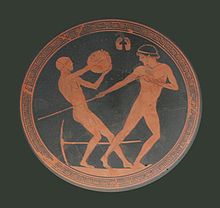Holder (sports equipment)

A holder (plural Halteres , ancient Greek ἁλτήρ , plural ἁλτῆρες , from ἅλλομαι hállomai "jump") was a piece of sports equipment in antiquity that served both as a weight to strengthen the swing in long jump ( jump weight ) and as a dumbbell for muscle training.
use

Haltes as jumping weights were always used in pairs and contributed significantly to the result, since the long jump was made from a sequence of several successive jumps from a standing position or with only a short run-up. The long jump was practiced especially at the Olympic Games as part of the Pentathlon . From pictorial representations and isolated literary mentions it was deduced that the athletes swung the halter forward when jumping and let it fall during the last jumps of the jump sequence.
There were no uniform weights and measures, and sometimes a holder had a different weight than its counterpart. Each athlete had his own halteres, which is probably the reason that they were offered relatively often as ordinances by victorious pentathletes. They were kept tied together and hanging on the wall.
to form
The originals and depictions in vase painting that have been preserved show three different basic shapes: a piston shape , a spheroid and a cylindrical shape.
Piston-shaped holders were made of lead or clay, although the clay objects were probably only votive offerings that were not used. The initial shape was a curved rectangle with unequal sides ( oblongum ), the ends of which were bent to one side and formed into two pistons at the ends. The pistons were initially about the same size, but the front ends were later enlarged, which increased the momentum when jumping. Until about 500 BC BC this form seems to have been used alone, then together with the spheroid. From this time both types can be found, in some cases even on a single picture.
The spheroid shape can only be proven by depictions on red-figure vases, only a few examples made of stone have survived in the original. The details of the holders are very different, but all have an elongated basic shape and a shape adapted to the athletes' fingers. Holders are known which are only thinner in the middle, have troughs on one side for the fingers and on the other side for the thumb or are also provided with a hole for the thumb. While the length is about 25-30 cm throughout, the pieces obtained have different weights of about 2 to 4.5 kg. A literary description of this form can be found in Pausanias . This describes a statue of the personified competition Agon created by Dionysius of Argos , which was set up as a consecration gift by Mikythos in the Zeus sanctuary Olympia . Agon is holding Halteres' hands, which are described as semicircular, but the semicircle is more elliptical than circular. They are made in such a way that the fingers fit through exactly, "like through the handle of a shield".
Only a single example of the cylindrical shape from Roman times has survived. The piece is made of limestone and has indentations for the hand, representations of this type can be found occasionally on wall paintings and mosaics. Several descriptions in Pausanias suggest that this type must have completely displaced the other two types from at least the 2nd century onwards, in which Halteres are described as ancient in statues.
literature
- Julius Jüthner : Holder. In: Paulys Realencyclopadie der classischen Antiquity Science (RE). Volume VII, 2, Stuttgart 1912, Col. 2284 f. ( Digitized version ).
Web links
Remarks
- ↑ Ulrich Sinn : The ancient Olympia. Gods, games and art. 3. Edition. CH Beck, Munich 2004, ISBN 3-406-51558-4 , p. 140.
- ↑ Ulrich Sinn: The ancient Olympia. Gods, games and art. 3. Edition. CH Beck, Munich 2004, p. 164.
- ↑ a b Stephen G. Miller: Ancient Greek Athletics. Yale University Press, New Haven CT 2006, ISBN 978-0-300-11529-1 , p. 64.
- ↑ Pausanias 5:26 , 3.
- ↑ Pausanias 5:27 , 5 ; 6, 3, 10.

